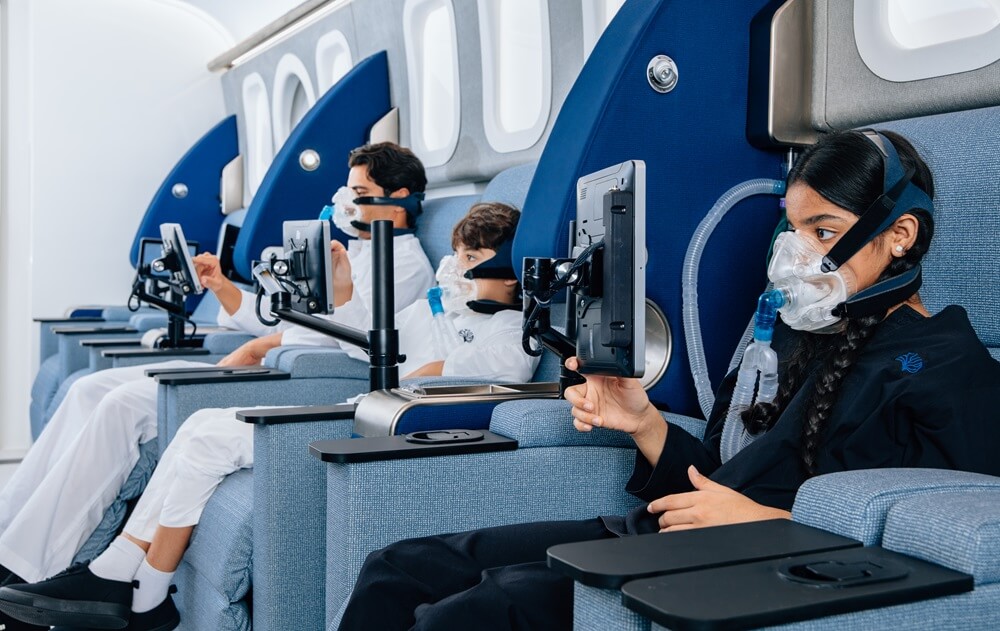
More Than a Label: Making Sense of Autism Symptoms and the Spectrum


If you’re reading this, chances are you’ve noticed something different about your child—something you can’t quite explain but feel in your heart needs attention.
Maybe your child isn’t speaking yet, avoids eye contact or seems overwhelmed by sounds and lights. Perhaps you’ve heard the word “autism” mentioned and felt a wave of uncertainty, fear or even guilt.
We want you to know: You are not alone, and your commitment to understanding your child shows you’re doing your best.
Autism Spectrum Disorder (ASD) is a complex condition that deserves time, understanding and thoughtful guidance.
At The Brain & Performance Centre, a DP World Company, we’re here to help you make sense of ASD symptoms, not with judgment, but with clarity and compassion.
Our goal is not to change who your child is, but to understand what they need to feel confident in their everyday pursuits and to do everything in our power to support that journey.
Understanding ASD and Its Common Symptoms
ASD is not a disease. It’s a collection of symptoms that can have different underlying causes. These symptoms can affect communication, behaviour, executive function and sensory processing.
Every child is unique, and so are the signs they may show. Recognising those signs is critical to seeking appropriate, effective and timely care.

Early Signs of Autism in Toddlers and Young Children
Early signs of autism often appear between 12 and 24 months. Some parents notice signs even earlier.
Common symptoms include:
- Delayed speech or limited verbal communication
- Lack of eye contact or response to their name
- Limited interest in playing with others or pretending
- Repetitive behaviours like rocking, hand-flapping, or spinning objects
- Strong reactions to certain sounds, lights, or textures
Every child develops at their own pace, but if these signs persist or grow more noticeable over time, it’s worth speaking to a qualified specialist.
Autism Symptoms in Older Children and Young Adults

For some individuals, certain symptoms may become more apparent over time. Some children aren’t diagnosed with ASD until they are older.
Autism symptoms don’t disappear with age, but many people learn to adapt, especially when supported with the right strategies. In older children and young adults, autism may show up as:
- Struggles with social rules or interpreting tone and body language
- Difficulty making or keeping friends
- An intense focus on specific topics or routines
- Discomfort with unexpected changes
- Difficulty organising tasks or managing time (executive functioning issues)
The Different Types of Autism Within the Spectrum
As our understanding of autism has evolved, it’s become clear that ASD is not a one-size-fits-all condition. People experience it in vastly different ways.
For example, some individuals may be nonverbal and require daily support, while others may have strong language skills but still face challenges with social interaction, flexibility or sensory processing.
To reflect this diversity, the term “Autism Spectrum Disorder (ASD)” was officially introduced in 2013 in the fifth edition of the Diagnostic and Statistical Manual of Mental Disorders (DSM-5).
The updated term captures the wide range of traits, behaviours and support needs seen across individuals.
Prior to 2013, autism was diagnosed using more specific subtypes:
- Classic Autism (Autistic Disorder): Involves significant language, social and behavioural challenges
- Asperger Syndrome: Often includes strong language skills but difficulty with social interaction and inflexible thinking
- Pervasive Developmental Disorder Not Otherwise Specified (PDD-NOS): A milder or atypical presentation of autism symptoms
- Childhood Disintegrative Disorder (CDD): A rare condition where a child develops typically but then loses skills rapidly
While now grouped under the broader ASD umbrella, these earlier classifications still help illustrate how symptoms may vary across individuals.
Levels of ASD (and Why They’re Misleading)
When exploring ASD, families may hear terminology such as level 1, level 2 and level 3. These levels are part of the clinical framework the DSM uses to describe how much support an individual might need in daily life:
- Level 1: Requires support
- Level 2: Requires substantial support
- Level 3: Requires very substantial support
While these terms can offer guidance in assessing support needs, they can also be misleading.
In reality, support needs can vary widely from one area of life to another, and they often change over time as a child grows, learns and receives the right interventions. That’s why we prefer to focus on personalised care rather than labels.
Contributing Factors or Co-Occurring Conditions
In many cases, children diagnosed with autism may also have other medical conditions that contribute to or coexist with their symptoms (comorbidities).
Some of the conditions that may be present alongside autism or influence how symptoms present:
- Post-concussion syndrome (PCS)
- Cerebral palsy
- Encephalopathies
- Meningitis
Understanding these comorbidities is crucial in seeking the right care.
For example, at The Brain & Performance Centre, children with autism and a history of encephalopathy, meningitis or cerebral palsy often respond especially well to targeted treatments like hyperbaric oxygen therapy (HBOT) and post-concussion syndrome treatment.
These therapies support neurological healing and can improve quality of life.

Autism in the GCC
Reported autism rates across the GCC vary widely. Studies report:
- In Bahrain, the rate may be “as low as 4.3 per 10,000 children.”
- In Saudi Arabia, Oman and the UAE, it’s “between 20-29 per 10,000.”
- In Qatar and Kuwait, it’s “over 30” per 10,000.
- In the UAE, autism makes up “12% of all disabilities.” Other autism statistics in the UAE indicate ASD impacts “1 in 146 births.”
These numbers, however, may not reflect how common autism really is. Many cases go undiagnosed due to limited diagnostic tools, cultural stigma or lack of awareness around the early signs and diverse ways autism can appear.
Why Early Awareness and Diagnosis Matter
Children diagnosed early and accurately with ASD and provided with targeted therapies experience better outcomes.
- “Interventions initiated early—especially those before the age of three—often lead to substantial advancements in social communication, cognitive skills, and adaptive behaviors.”
- Research has found emotion regulation therapies “improved ER [emotional regulation]/ED [emotional dysregulation], internalizing, social skills” for those accurately diagnosed with ASD.
- A recent study illustrates promising results for those who undergo HBOT, showing that children with ASD who received this therapy “acquired more verbal skills than their counterparts in the control group.”
In some cases, what appears to be autism may actually be caused by a specific underlying condition (for example, some forms of epilepsy can manifest as ASD symptoms; treating the epilepsy will improve the displayed symptoms).
While early intervention can make a profound difference in childhood, it’s never too late to gain the benefits of proper diagnosis and treatment. Many young adults find that a diagnosis—no matter when it happens—can bring clarity, connection and access to meaningful support.

Why Getting an Autism Diagnosis Can Be Challenging—and How We Help
In the GCC, families seeking an ASD diagnosis may face long wait times, inconsistent evaluations or fear of social judgment. As a result, many children go undiagnosed for years. That’s why The Brain & Performance Centre offers a clear, compassionate and science-backed path to diagnosis.
Our youth assessment process is designed to identify symptoms of autism and other conditions early and accurately. We use advanced diagnostic tools and spend time understanding your child’s complete medical and developmental background—because, again, autism is not one-size-fits-all.
We also help families differentiate between autism and conditions with overlapping symptoms, giving them clarity and confidence in the next steps.
Learn more about our autism test here.

Real Lives, Real Outcomes
We’ve witnessed children who were once nonverbal begin to express themselves in meaningful ways. We’ve supported families that felt overwhelmed and finally found answers—and a clear path forward. These stories aren’t rare exceptions. They’re at the heart of everything we do.
When autism is identified early and met with the proper support, children can build meaningful relationships, gain independence and live fuller lives alongside the people who love them.
Dr Craig Cook—CEO of The Brain & Performance Centre in Dubai—shares his personal experience as the father of a son with nonverbal autism. His story is honest, compassionate and above all, filled with hope for families walking a similar path.
Take the Next Step
If you suspect your child may be showing signs of autism, don’t wait. We invite you to contact us for a confidential consultation. Our team is here to listen, guide and walk with you every step of the way.
For more information, read our article on factors that affect child development or explore our autism FAQs.
